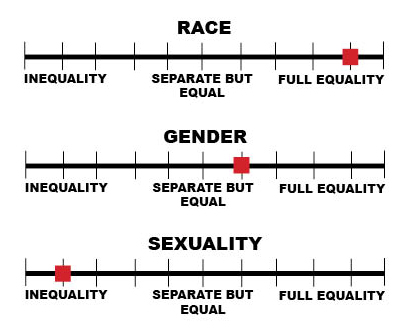Three cultural-biblical issues intertwine today to hold the Christian church in knots of conflict. Part of that conflict concerns whether the three cords are cut from the same cloth or not.
These strands are race, gender and sexuality.
From a modern vantage, many white Christians would declare the race issue is old news — something long ago settled. Quite a few Blacks, Hispanics, Asians and Native Americans would beg to differ. Yet race is the first thread of this cord of three we must reckon with. How we understand race influences how we understand gender and sexuality — even if you don’t think these three are “the same.”
Within the church, all three issues may be viewed on a continuum of understanding — both individually and in interaction with each other. The graphic below illustrates one way to imagine this continuum ranging from “inequality” on one end to “full equality” on the other end and multiple stops in between.
“Within the church, all three issues may be viewed on a continuum of understanding — both individually and in interaction with each other.”
But please note this graph and the words I am writing come from a white male heteronormative perspective. There is no scale shown here for inclusion or exclusion of white people. And the assumption of the “gender” scale is that it concerns the acceptance of women.
I’m presenting the scale this way because that is the default starting point in American Christianity. Everyone and everything is judged against the perspective of the white male experience. And yes, that experience is not shared by all white males, but is the majority opinion if not experience.
We do not speak of white male life experience compared to Black female life experience. We speak of it the opposite way. We do not measure heterosexual life against gay or lesbian experience; we look at it the opposite way.
So with that caveat, look back to the graphs and imagine them not only as three separate sliding scales but as a multidimensional grid. Today’s churches fall at different points within this three-dimensional space. Some churches live with all the sliders to the right, while some still with all the sliders to the left.
For this article, I’ve placed the red buttons where they fall in many evangelical churches. They are race conscious — even if not fully inclusive —and they tend to see women as “separate but equal” in leadership capacity. But they fall far to the “inequality” side on sexuality, which is my label here for non-heteronormative.

God in three sliders?
Liberals and progressives like me argue that all three issues should be treated alike, or cut from the same cloth. To us, these are basic human rights granted by God. No one has a choice about whether they are born Black or white or brown, male or female or nonbinary, or homosexual or heterosexual.
To us, all three sliders have been set at a factory default all the way to the right — full equality and inclusion for everyone.
But to other Christians, the comparison I’ve just made isn’t fair and isn’t biblical. They do not see gender or sexuality as comparable to race. That’s because the Bible tells them so — as does American culture.
Complementarians, for example, believe God has created a hierarchical order in creation related to gender. They are certain the Bible teaches that men are to have authority over women, that the role of pastor and spiritual overseer is reserved only for men. From this view, God never intended the slider to go all the way to the right.
“They do not see gender or sexuality as comparable to race. That’s because the Bible tells them so — as does American culture.”
Of course, there are various degrees of believing this and practicing it, which is why there are multiple points along the continuum.
Regarding sexual orientation (which by the way is not the same as gender identity, but that’s another column), some Christians also believe the factory default setting for our continuum is hardwired to the left side and must not cross too far to the right. In the most extreme view, there can be no inclusion of gay, lesbian and bisexual people because this is a choice people have made to deviate from God’s good plan.
Most — but sadly not all — modern-day Christians see racial identity as a gift from God that clearly is neither a choice nor a limitation. Remember that in the “good old days” of American history, many a pastor taught that racial identity was not a choice but still was a limitation. By this reasoning, God made people Black or white to indicate their intelligence and station in life.
These preachers of yore found Scriptures — misread and taken out of context — to support their views. Today, we read the Bible differently even if we don’t always act differently. Not many modern-day racists are using the Bible to make their case.
From the perspective of people like me, this should be a cautionary tale to those who claim biblical inspiration for saying men and women have been assigned different roles in church and home. We argue that they, like the saints of old, are misreading and misapplying holy Scripture to maintain the patriarchy.
Even if biology, personal experience and common sense demonstrate otherwise, they will not deviate from what they believe the Bible teaches. If there is dissonance between biblical teaching and lived experience, the problem always must be with our lived experience.
To be fair, they do not see themselves as misogynists. They seem themselves as living biblically.
The same can be said for the continuum of sexual orientation. While I see the variations in sexual orientation found throughout creation as signs of God’s good plan, others see such as signs of a sinful world run amok. Again, they believe the Bible assigns the red button on our continuum to a factory default of non-inclusion. Or perhaps inclusion with limits.
That’s why so many churches say they “welcome everyone” but don’t allow everyone equal opportunity for church leadership. There are limits to the welcome, which they contend are based on biblical teaching.
The three-dimensional
Where things get really confusing is when we try to comprehend where any church or any pastor or any person stands on the combination of these three scales. Move the imaginary red buttons on the scales all around and envision the multiple combinations that can be created.
“All three issues are emotional and controversial and hard to talk about.”
In our current context, the debates over church identity are not one-dimensional. They are three-dimensional or more. And all three issues are emotional and controversial and hard to talk about.
Pity the poor church today that is coming to grips with its racist past while determining whether to allow women to preach and being asked to welcome gay people as Sunday school teachers and deacons. That leads to multidimensional conflict.
Acts of the Apostles
Such conflict is not new to the Christian church. It has been with us from the beginning, although in different forms. This is where the second chapter of Acts — really the entire book of Acts and especially chapter eight — offers a model for us today.
In my own church, before we embarked on an 18-month study regarding LGBTQ inclusion, we had a summer preaching series on the book of Acts. This was not a setup to make the case for inclusion — as some critics charged — but was a setup for how the church should listen to the voice of God and compare it to both tradition and Scripture.
You can read Acts and come to different conclusions on LGBTQ inclusion in the church. It does not give us an answer on this question. It does show us a process for discernment that says God still speaks.
And as we listen for the voice of God, we might consider where our dials are set based on tradition and where they are set on the movement of the Holy Spirt among us. Even if you don’t think gender and sexuality are “like” race, consider how wrong the church was for so long about race and tie your knots carefully.
Mark Wingfield serves as executive director and publisher of Baptist News Global. He is the author of Honestly: Telling the Truth About the Bible and Ourselves and Why Churches Need to Talk About Sexuality.


